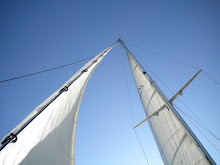After a peaceful night at anchor, we woke for an early start. We pulled up the anchor and I drove us out of the bay. We sighted a lovely Ketch coming toward us from the west, and I felt a sense of kinship imagining her recent travels off the coast.
We pulled out into the channel, turned right and headed east. The forecast was for a bit more wind today, so we looked forward to some sailing. We raised the main, which helped our progress, and the crew settled into the watch schedule. Deb took advantage of the warmth to read on the foredeck; Peter even napped a bit in the sails on the bow. August in the northwest.

As the day warmed, we removed coats and sweaters to feel the sun on our skin. We played with the auto-helm given the calm conditions. Look, no hands!

As the day passed, we realized that we would not make Port Townsend until after dark, so decided to anchor in Port Angeles. This was a good decision, as we had time to have a delicious meal and an early night.

On Wednesday morning, we woke to heavy fog in the Strait. But such a difference in our view of this challenge. Our last boat had no radar, so heavy fog meant you go back to port and wait. Now, although we were very cautious, we could keep going. Visibility varied through the day from less than a mile to an estimated 3 miles, so it was reasonable to travel. We moved just ouside of the shipping channel, and watched the chart plotter and radar. We had a crew member on the bow and blew our air horn periodically as required.
 We passed several sailboats going the other way. It seemed magical to first see them on the radar, then staring intently to see them emerge ghost-like from the fog.
We passed several sailboats going the other way. It seemed magical to first see them on the radar, then staring intently to see them emerge ghost-like from the fog.We rounded the point and headed south. The trip from Port Townsend to Bainbridge Island is one we have done so many times on our prior boat, Zenobia, so it was very relaxing to navigate these waters. We raised all of the sails - the main, genoa and staysail.
The quiet was lovely, and we soon found ourselves reading, knitting and chatting in the cockpit. We hadn't expected this kind of slow, cruising relaxation on this leg of the trip, so everyone was very happy.
 By late afternoon we sighted Shilshoe Marina, followed by the Seattle skyline. Down around the red buoy and we pulled into our new home in Harbor Marina. Simon, Becky, Charley and Deb treated Peter and me to a celebration dinner at the Harbor Pub - smiles all around!
By late afternoon we sighted Shilshoe Marina, followed by the Seattle skyline. Down around the red buoy and we pulled into our new home in Harbor Marina. Simon, Becky, Charley and Deb treated Peter and me to a celebration dinner at the Harbor Pub - smiles all around!















